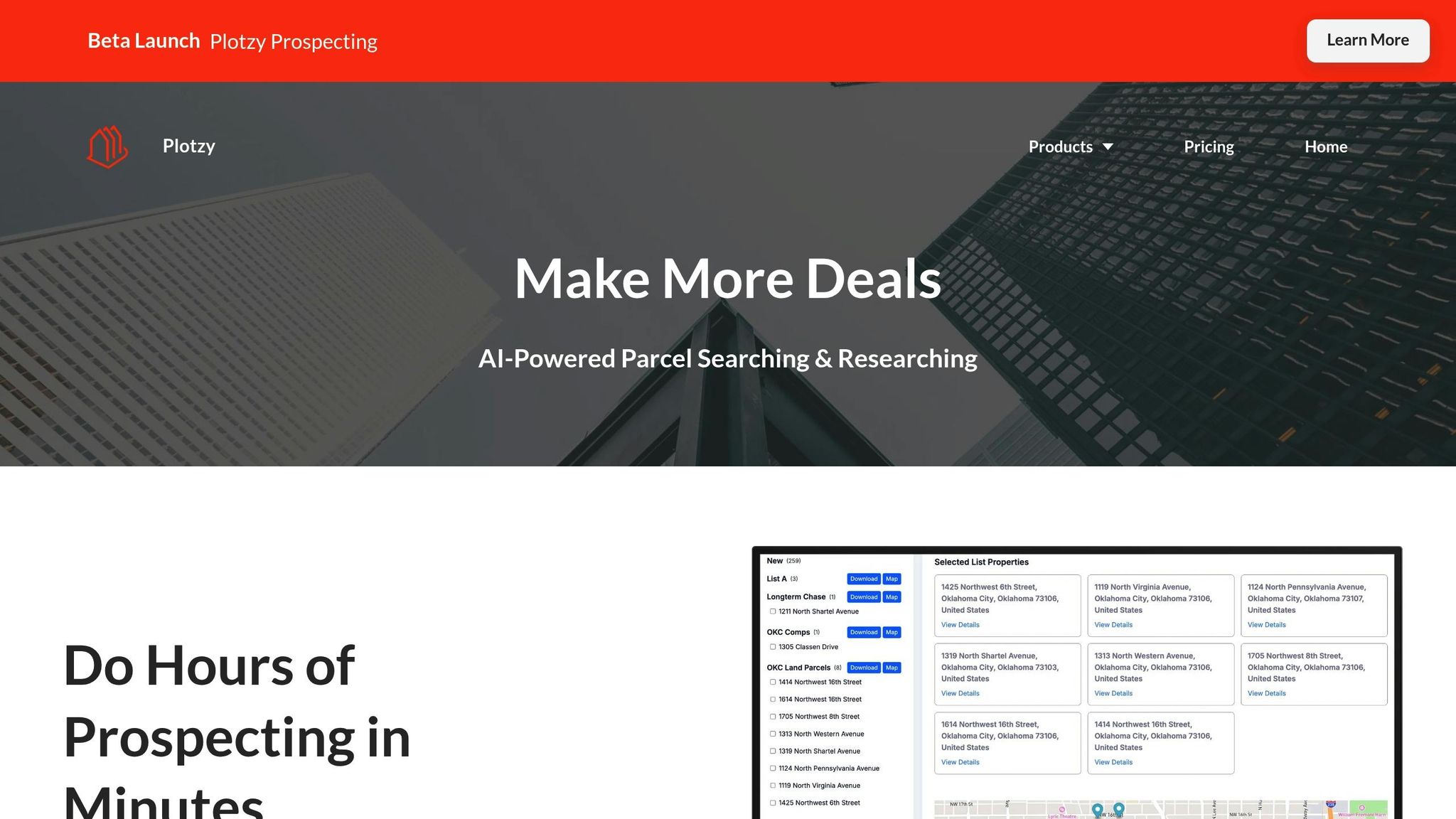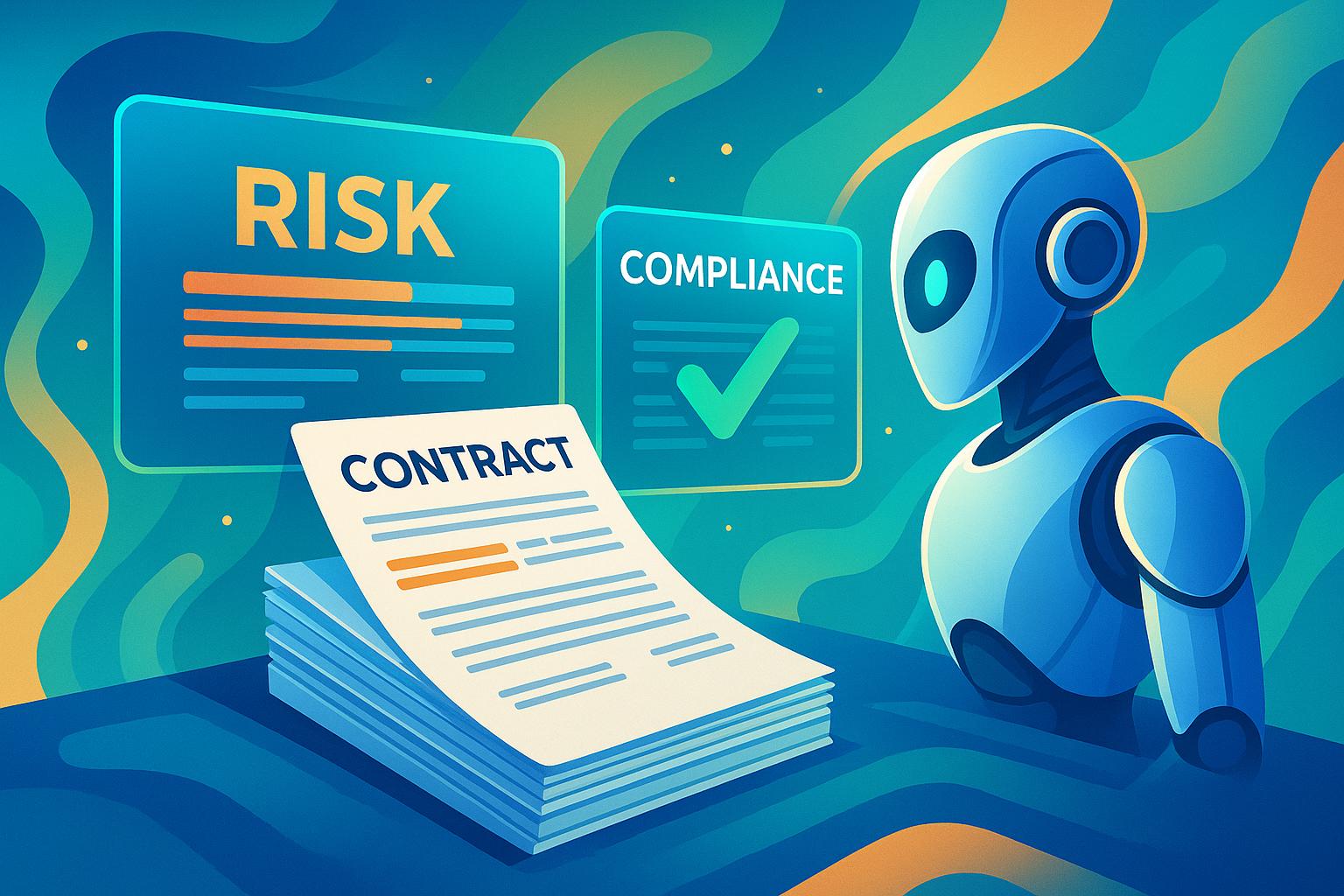AI is reshaping how lease agreements are reviewed, offering faster, more accurate ways to identify legal risks and compliance issues. Manual reviews often miss critical details due to fatigue, tight deadlines, or complex clauses. AI tools, like Plotzy, automate these processes with features like Natural Language Processing (NLP), pattern recognition, and machine learning. Here's what you need to know:
- Legal Risk Reduction: AI flags ambiguous clauses, unusual terms, and compliance gaps in leases, helping avoid costly disputes or fines.
- Efficiency: AI processes large volumes of documents quickly, ensuring consistent and accurate reviews that save time.
- Compliance Monitoring: AI cross-checks lease terms with zoning laws and market norms, keeping up with regulatory updates.
- Plotzy Features: Tools for zoning research, ownership verification, and lease data analysis simplify due diligence.
AI-powered lease analysis is becoming essential for real estate professionals aiming to minimize risks and improve accuracy. Platforms like Plotzy centralize these tools, offering a streamlined approach for managing complex lease portfolios.
Lease Agreement Audit Tool powered by AI
Problems with Manual Lease Analysis
The traditional way of reviewing leases comes with risks that can leave real estate professionals exposed. As the commercial real estate landscape grows more complex and legal requirements tighten, relying on manual processes to analyze lease agreements is proving increasingly insufficient.
Challenges of Manual Processes
Manual lease reviews are riddled with limitations that make thorough analysis difficult. For one, time constraints often force professionals to rush through documents, especially when managing multiple properties or tight deadlines. This hurried pace can lead to missed details in critical clauses. The problem only worsens as lease agreements grow more intricate.
Another issue is human fatigue. Dense legal language can quickly exhaust reviewers, increasing the likelihood of overlooked risks. Add to that the inconsistency of manual reviews - different reviewers may prioritize different aspects, leaving gaps in the process. Without a standardized approach or comprehensive templates, important details can easily go unnoticed.
Knowledge gaps also play a role. No single reviewer can stay fully updated on zoning laws, municipal requirements, and market conditions across all jurisdictions. This lack of familiarity with specific local regulations or recent legal updates can result in missed compliance issues, creating potential liabilities.
The Increasing Complexity of Lease Agreements
Modern lease agreements are no longer straightforward documents. They now include intricate clauses covering everything from environmental compliance and technology infrastructure to pandemic-related provisions and complex financial calculations. These agreements often span multiple jurisdictions, each with its own set of rules, and feature interconnected clauses that reference various sections. This level of complexity makes manual reviews even more challenging, increasing the chances of missing conflicts or unintended consequences hidden within the fine print.
How AI Anomaly Detection Works in Lease Analysis
AI anomaly detection is reshaping lease analysis by leveraging advanced algorithms to uncover patterns, inconsistencies, and potential risks that might escape human reviewers. Unlike manual processes that depend on individual expertise and meticulous attention, AI systems can handle vast amounts of lease data simultaneously while maintaining consistent accuracy.
This technology establishes baseline patterns by analyzing thousands of lease agreements. It then flags deviations that may signal issues, catching subtle problems that traditional reviews might overlook - especially in complex, multi-jurisdictional agreements or time-sensitive transactions. By doing so, AI bridges the gap between conventional reviews and a more precise, automated approach.
AI Methods for Lease Analysis
AI employs a combination of tools and techniques to analyze leases, including Natural Language Processing (NLP), pattern recognition, and machine learning. These methods work together to dissect legal text, compare lease structures to established norms, and improve risk detection over time.
Natural Language Processing (NLP) plays a central role in AI-powered lease analysis. It breaks down legal text into manageable components, identifying key terms, clauses, and relationships between sections. NLP algorithms can detect deviations from standard industry language or flag conflicting clauses within a document.
Pattern recognition algorithms analyze the structure of leases to identify unusual terms or arrangements. By learning from extensive databases of lease agreements, these systems can differentiate between standard and irregular provisions. For example, the AI might flag leases with unusually long notice periods, non-standard rent escalation formulas, or atypical termination clauses for further review.
Machine learning models enhance detection by learning from past analyses and outcomes. These systems adapt to new clause types, evolving legal standards, and shifting market conditions. The more leases they process, the better they become at distinguishing acceptable variations from genuine compliance risks.
Additionally, AI cross-references lease terms with current zoning laws and municipal requirements. This feature is particularly valuable for properties spanning multiple jurisdictions, as the system can instantly verify whether lease provisions align with local land use rules, building codes, and other regulations.
Spotting Unusual Terms and Ambiguous Language
AI is especially adept at pinpointing unclear language, unusual clauses, and compliance gaps. For instance, it flags phrases like "reasonable efforts" or "industry standard" when they lack clear definitions. The system also highlights non-standard co-tenancy requirements, atypical percentage rent calculations, and environmental provisions that don’t align with updated EPA guidelines.
The technology also identifies unusual financial arrangements that could pose risks. This includes rent structures that deviate significantly from market norms, security deposits that seem excessive or inadequate, and payment terms that might create cash flow challenges. It can even detect escalation clauses that compound in ways that could lead to affordability issues in the future.
sbb-itb-11d231f
How Plotzy Helps with AI Lease Analysis

Plotzy takes AI's risk detection capabilities and applies them to streamline lease analysis, making it easier to address legal concerns. By combining property research with automated risk detection, Plotzy offers real estate professionals a centralized platform for lease due diligence. Instead of juggling multiple tools and manual processes, users can access everything they need in one place. This unified approach helps pinpoint potential legal risks, making it especially useful for managing complex portfolios or navigating time-sensitive transactions where compliance is critical.
AI-Powered Lease Data Collection
Plotzy simplifies lease data collection by pulling information from public records and tax assessors, keeping property details - like ownership history, tax status, and encumbrances - constantly updated. This automated process eliminates the need to manually search through government databases and public records. Instead of spending hours researching each property, users can access a consolidated, real-time database.
The platform's AI analyzes this data to detect patterns and anomalies, flagging any discrepancies between lease documents and public records. This ensures potential legal risks are identified early. With this robust data foundation, users can seamlessly move on to zoning and municipal compliance analysis.
Easy Zoning and Municipal Research
Plotzy makes it simple to verify lease compliance with local zoning laws and municipal requirements. Users can filter parcel and owner results based on project needs, such as permitted land use or acreage, to quickly spot zoning conflicts. The platform also allows searches for properties by permitted uses, helping users build targeted parcel lists for deals.
The Instant Zoning Q&As feature provides immediate answers to zoning-related questions, removing the need to reach out to municipal offices for basic information. This tool is particularly helpful during lease negotiations, where quick clarification on zoning restrictions - like setback requirements, parking ratios, or signage allowances - can be crucial.
Plotzy's pricing makes these tools accessible to a wide audience. The Basic Plan costs $65 per month and includes features like the Permitted Use Filter, Municipal Resources, and Instant Zoning Q&As. For more advanced needs, the Pro Plan at $200 per month adds tools like Custom Shapefiles for in-depth geographic analysis.
Finding Owner Contact Information for Due Diligence
Plotzy also automates ownership verification, a critical step in lease due diligence. Its AI-powered tools retrieve and provide accurate owner contact information, allowing users to streamline communication and speed up deals. This integration ensures that users can access current owner details alongside property and zoning data, reducing the risk of relying on outdated information.
The platform continuously updates its database, reflecting recent property transfers, corporate changes, or updated contact details. This real-time accuracy addresses one of the most common challenges in lease analysis: outdated ownership records.
Users can also organize and export lists of properties and their associated owner contact information, making it easier to manage multiple deals at once. This feature is especially helpful for portfolio acquisitions or when analyzing lease assignments involving several properties.
Plotzy offers tiered pricing for accessing owner contact information. The Basic Plan provides 200 matches per month for $65, while the Pro Plan includes 1,000 matches monthly for $200. User feedback highlights the platform's reliability and efficiency in delivering accurate data.
Proven Benefits of AI Lease Analysis
For real estate professionals, adopting AI-powered lease analysis tools can transform daily operations. These tools don't just save time - they help reduce legal risks, improve accuracy, and ensure stronger compliance. By moving away from manual processes, teams can reimagine how they handle lease reviews and manage risks. Below, let's break down the specific advantages these tools bring in terms of reducing legal exposure, speeding up reviews, and delivering consistent results.
Lower Legal Risk and Stronger Compliance
AI-powered lease analysis tools play a key role in minimizing legal risks and ensuring compliance. They automatically flag potential legal issues, such as discrepancies between lease agreements and public records, including ownership, zoning, and municipal data. This proactive approach helps prevent minor oversights from escalating into costly lawsuits or regulatory penalties.
Additionally, these tools bring consistency to the review process. By applying uniform standards across all lease documents, AI removes the uncertainty of individual judgment. This systematic approach ensures all leases are held to the same compliance benchmarks, giving legal teams greater confidence in their portfolios.
Faster Reviews with Improved Accuracy
Speed and precision are two areas where AI lease analysis truly shines. Tasks that once took hours - or even days - can now be completed in mere minutes. Manual data collection becomes a thing of the past as AI systems instantly pull information from integrated sources, freeing up teams to focus on higher-level strategies rather than tedious research.
AI's pattern recognition capabilities also catch subtle issues that might slip past human reviewers, especially during long, repetitive tasks. Unlike manual reviews, which are prone to errors caused by fatigue or oversight, AI tools maintain consistent accuracy, ensuring no detail is overlooked.
Comparing Manual and AI Lease Analysis
The differences between manual and AI-driven lease analysis are stark. AI offers a more systematic and reliable approach, thanks to automated data integration and consistent review protocols. This ensures that every lease document - no matter how complex - is reviewed with the same level of thoroughness. The result? Faster due diligence, improved reliability, and greater confidence in lease assessments.
The Future of AI in Lease Analysis
AI-powered lease analysis has become a cornerstone of commercial real estate operations. With lease agreements growing more intricate and regulatory landscapes constantly shifting, traditional manual review methods are struggling to keep up with the pace of modern transactions.
AI tools are transforming due diligence processes by going beyond basic lease reviews. Take Plotzy's platform, for example - it integrates lease analysis with a suite of property research tools. This means tasks like zoning verification, municipal compliance checks, and retrieving owner contact information can all be automated and handled within a single system. By streamlining these processes, AI not only saves time but also strengthens risk management.
But this shift isn’t just about adopting new technology. AI tools bring a proactive edge to lease analysis by automatically flagging anomalies and inconsistencies. These early warnings help teams tackle potential legal issues before they escalate into disputes or regulatory violations, saving both money and headaches.
Looking ahead, the real estate professionals who thrive will be those who embrace platforms that provide a full spectrum of property intelligence. Plotzy’s AI-powered platform illustrates this well, combining lease analysis with features like parcel searches, zoning research, and comprehensive property reports. This integrated approach ensures lease agreements are assessed within the larger framework of property details and municipal rules, creating a more complete and reliable evaluation process.
Future advancements will likely take this even further. Next-generation AI platforms are expected to instantly cross-check lease terms with zoning laws, ownership records, and compliance data. This kind of immediate verification will not only reduce the time required for due diligence but also offer real estate teams unmatched confidence in their lease reviews.
For commercial real estate teams aiming to minimize legal risks and boost efficiency, adopting AI-driven lease analysis is no longer optional - it’s essential for staying competitive.
FAQs
How does AI make lease agreement reviews faster and more accurate compared to traditional methods?
AI is transforming the way lease agreements are reviewed, thanks to natural language processing (NLP) and machine learning (ML). These technologies can pinpoint and extract critical details with impressive precision, cutting down on human errors. As a result, the process becomes more reliable while also reducing the risk of compliance issues.
On top of that, AI speeds up the review process by efficiently managing large volumes of leases in a fraction of the time it would take manually. This not only saves time and reduces costs but also frees up real estate professionals to concentrate on more strategic, high-value tasks. It's reshaping how complex lease portfolios are managed.
How can AI tools like Plotzy help identify legal risks in lease agreements and prevent disputes?
AI tools, such as Plotzy, are transforming how lease agreements are reviewed by spotting potential legal risks. They can identify ambiguous language, hidden liabilities, and inconsistencies in terms - issues that might otherwise go unnoticed and lead to disputes or even regulatory trouble.
By automating the review process and pulling out essential details, AI reduces the chance of human error while ensuring leases comply with zoning laws and municipal regulations. This streamlined approach helps real estate professionals steer clear of expensive misunderstandings and legal complications.
How does Plotzy's AI platform help real estate professionals stay compliant with zoning laws and municipal regulations?
Plotzy's AI platform takes the guesswork out of navigating zoning codes and municipal regulations. By breaking down complex rules across different jurisdictions, it offers clear insights into zoning classifications, building restrictions, and permitted property uses. This ensures real estate professionals can access precise, up-to-date information when they need it most.
What sets the platform apart is its commitment to staying current. It continuously updates its database to include the latest regulatory changes, helping users avoid legal pitfalls and make confident, well-informed decisions.

